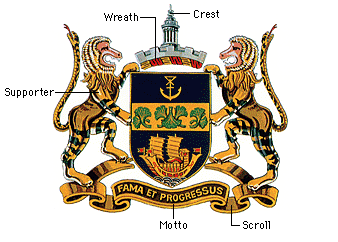Port & Harbor Bureau
The Port of Osaka's Coat of Arms
Created in 1980, as part of Osaka - Le Havre (French Republic) Sister Port Affiliation commemorations, the port's coat of arms was designed to express the `spirit of Osaka'. Accordingly, it was featured on a range of original gifts, including a shield, which were presented to the Port of Le Havre. Prior to the creation of the coat of arms, a simple design, combining a ship's anchor with the city symbol, a channel marker known as Miotsukushi, was used. However, in light of increasing internationalisation and the establishment of several sister port affiliations, a new port symbol was necessary. Coincidently, it was around this time that Mr Mamoru Mori, a coat of arms researcher, published his book, ゙European Coats of Arms". Upon meeting with the author, the port secured his full support and after six months of subsequent instruction, the Port of Osaka's coat of arms was completed. Complying with the official `Coat of Arms Design Regulations', the Port of Osaka's coat of arms' has received positive reviews, even when compared with the most distinguished of Japanese motifs. Famed for its originality, the coat of arms of the Port of Osaka enjoys a continued popularity.

《Blazon》
Created in 1980, as part of Osaka - Le Havre (French Republic) Sister Port Affiliation commemorations, the port's coat of arms was designed to express the `spirit of Osaka'. Accordingly, it was featured on a range of original gifts, including a shield, which were presented to the Port of Le Havre. Prior to the creation of the coat of arms, a simple design, combining a ship's anchor with the city symbol, a channel marker known as Miotsukushi, was used. However, in light of increasing internationalisation and the establishment of several sister port affiliations, a new port symbol was necessary. Coincidently, it was around this time that Mr Mamoru Mori, a coat of arms researcher, published his book, ゙European Coats of Arms". Upon meeting with the author, the port secured his full support and after six months of subsequent instruction, the Port of Osaka's coat of arms was completed. Complying with the official `Coat of Arms Design Regulations', the Port of Osaka's coat of arms' has received positive reviews, even when compared with the most distinguished of Japanese motifs. Famed for its originality, the coat of arms of the Port of Osaka enjoys a continued popularity.
The shield is comprised of three sections set against a blue background. The upper section features the old port symbol in yellow, while the lower section shows an ancient, double-masted Japanese ship, flying red ensigns and sailing over silver waves. Wedged between these two sections is a series of seven green Ginkgo leaves, arranged in a two-three-two pattern, atop a yellow fess.
The crown section shows the city hall belfry set upon a red and gold wreath.
The mythical 'Nue' - a creature with the head of a monkey, body of a racoon, tail of a snake, legs of a lion and the voice of a songbird, standing on either side of the arms. According to legend, the creature was slain by the vassal Minamoto during the reign of Emperor Konoe (1139 - 1155). Since, according to legend, the 'Nue' dwelt in the depths of the sea and forest, the buried monster was chosen to support not only the shield of the arms, but also, metaphorically speaking, the port as a whole. In addition, for the purpose of design, the original racoon body has been replaced with that of a lion. Other mythical Japanese creatures, such as the red-faced Tengu and the water-based Kappa were also considered, but the local 'Nue', was deemed to be the most suitable choice.
The port's motto, "Fama et progressus" (Fame and Progress) is inscribed upon the scroll.

Mr Mamoru MORI (1923 - 2000),
designer of the port's coat of arms.
(located at Miyakojima Hondori 3-18, Miyakojima-Ku, Osaka)
One night, during the reign of Emperor Konoe, in the year 1153, a monster appeared at the imperial palace, disturbing the household. A vassel known as Minamoto, managed to kill the intruder, which was found to be a 'Nue', a creature with the head of a monkey, body of a racoon, limbs of a tiger and tail lile a snake.<
After being paraded in and around Kyoto, the slain Nue was then placed in a canoe and set adrift on the Yodogawa River. The corpse floated downstream, coming ashore at the swamplands. (present-day Miyakojima District)
The villagers, fearing the curse of the 'Nue', carried out burial services and constructed a burial mound, known as 'Nuetsuka'. The memorial site underwent repairs in 1868 and 1957, utilising funds from the prefectural government and citizens respectively. Even today, the Miyakojima District is home to a 'Nue Memorial Preservation Society', which oversees the site.